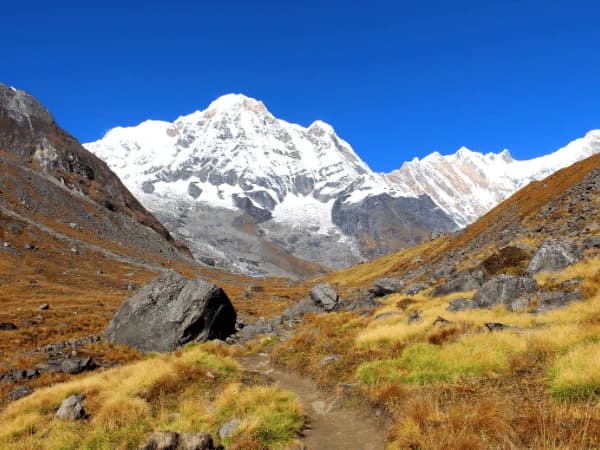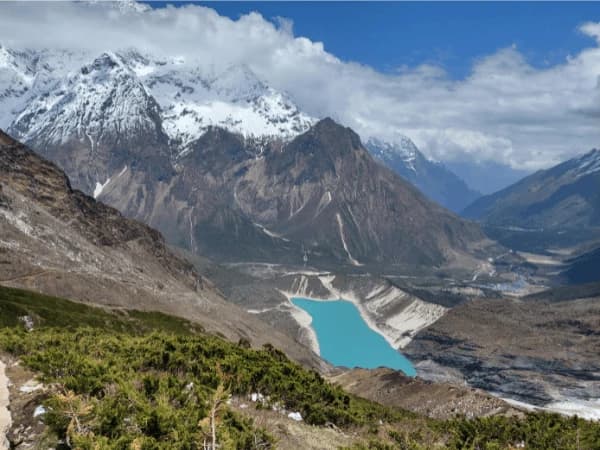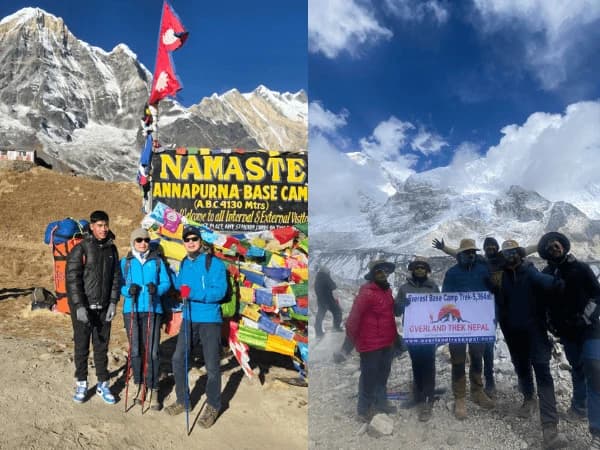Lobuche East Peak (6,119 m) is one of Nepal’s most stunning trekking peaks, offering unmatched views of Everest,Lhotse, Ama Dablam, and the Khumbu Glacier. While the climb is suitable for trekkers with good fitness, it requires solid preparation in training, gear, acclimatization, and logistics. In this complete guide, we share everything you need to know for your Lobuche Peak climbing preparation, from a fitness plan and gear list to permit fees, best climbing seasons, and sample itineraries. You’ll also discover why combining this climb with the Everest Base Camp trek is a popular choice. With Overland Trek Nepal’s expert guides, your journey will be safe, well-planned, and unforgettable. Let’s dive in.
How to prepare for the Lobuche East Peak climb in Nepal?
Lobuche East Peak Climbing at a Glance
Lobuche East Peak (6,119 m) is one of Nepal’s most iconic trekking peaks, offering climbers breathtaking views of Everest, Lhotse, Ama Dablam, and the Khumbu Glacier. For many adventurers, it’s the perfect blend of trekking and mountaineering, challenging enough to be exciting but still accessible for those with good fitness and determination. However, how to prepare for the Lobuche East Peak Climb in Nepal? It is the major query we get from many mountain enthusiasts.
Preparing for Lobuche Peak is about more than just booking a trip. You’ll need the right training, gear, acclimatization strategy, permits, and a clear understanding of the climb itself. With Overland Trek Nepal’s experienced guides and carefully designed itineraries, you can approach your climb with confidence and safety. With over 10 years of experience in trekking and peak climbing in Nepal, we are here to lead you to the summit of the highest trekking peaks of Nepal.
This guide covers everything you need for Lobuche Peak climbing preparation, from your training plan and gear list to the best time to climb, permits, costs, safety tips, and sample itineraries. Whether you are doing the longer version of Louche Peak with EBC Trek or Short Lobuche Peak climbing in Nepal, preparation and planning are must crucial part of this journey.
Understanding Lobuche East Peak and Its Climbing Challenges
What makes Lobuche East a popular trekking peak in Nepal?
Lobuche East is located in the Khumbu region, near Everest Base Camp, making it an ideal peak for trekkers wanting to add a mountaineering challenge to their Everest adventure. It’s classified as a “trekking peak” by the Nepal Mountaineering Association (NMA), meaning it doesn’t require a full expedition permit like higher peaks. Recently, similar to Mera Peak Climbing, Lobuche Peak has been attracting many mountaineers from around the world.
The Lobuche East climb offers stunning panoramic views of Everest, Lhotse, Makalu, Ama Dablam, and Cho Oyu. Additionally, the climbing route follows the famous Everest Base Camp Trek route, giving you the chance to explore the EBC while completing the climb. Most climbers combine their Lobuche Peak climb with a visit to EBC. The trek combines non-technical hiking with a final technical summit push using ropes and crampons.
Lobuche East vs Lobuche West, which one is right for you?
- Lobuche East is more accessible and popular, suitable for fit trekkers with some basic climbing training.
- Lobuche West is a true expedition peak, requiring advanced technical climbing skills, and is far less attempted.
- For most climbers, Lobuche East is the ideal first Himalayan climb before attempting higher peaks like Island Peak or Mera Peak.
Physical and Mental Training for Lobuche East Peak

Fitness plan for climbing Lobuche Peak at 6,119 meters
A training plan for Lobuche East Peak should start at least 8–12 weeks before departure. Without proper training, even if you are an experienced climber, it can be difficult. Physical preparation is so important, especially when you are doing high-altitude trekking or climbing. So, how to prepare for the Lobuche East Peak Climb in Nepal physically?
- Cardio: Hiking, running, cycling, or stair climbing for 45–60 minutes, 4–5 days a week.
- Leg strength: Squats, lunges, step-ups with weight to build climbing endurance.
- Core stability: Planks, mountain climbers, and balance exercises.
Endurance and strength workouts for Himalayan climbs
Long hikes with a backpack simulating trek conditions are the best preparation. Carry 8–10 kg during training to get used to summit day loads. Combine gym training with outdoor hiking for maximum benefit.
How to prepare for the Lobuche East Peak Climb in Nepal mentally?
At high altitudes, fatigue, cold, and thin air can challenge even the fittest climbers. Train your mind to push through discomfort by:
- Practicing long, slow climbs with minimal breaks.
- Staying positive when conditions get tough.
- Visualizing the summit and the journey back.
Best Time to Climb Lobuche East Peak

Choosing the right season is one of the most important parts of your Lobuche Peak climbing preparation. The weather in the Everest region can change quickly, and the conditions you face will directly impact your safety, comfort, and summit success. The two prime climbing seasons are spring (March–May) and autumn (September–November) — each offering unique advantages.
Climbing Lobuche Peak in Spring (March–May)
Spring is often considered the most pleasant time to climb Lobuche East Peak. The days are longer, the temperatures warmer, and the trails come alive with blooming rhododendron forests in the lower elevations. As you ascend higher, you’ll find stable snow and generally predictable climbing conditions.
Another advantage of spring is that it aligns with the Everest climbing season. This means the Khumbu region feels alive with expedition activity, and you may share parts of your journey with mountaineers heading for Everest, Lhotse, and other Himalayan giants. The clear skies of April and early May offer spectacular panoramic views, making your summit photographs truly unforgettable.
Why climb Lobuche Peak in the Spring Season?
- Comfortable daytime temperatures and milder nights compared to autumn.
- Beautiful rhododendron blooms along the lower trails.
- Stable snow conditions on the summit route.
- High energy in the Everest region with other expeditions in progress.
Lobuche East Autumn Season (September–November) Benefits
Autumn is the most popular season for trekking and climbing in Nepal. Post-monsoon skies are crystal clear, offering some of the sharpest and most dramatic mountain views you can get all year. The weather is typically dry and stable, with very little risk of heavy snowfall early in the season.
While temperatures are colder than in spring, especially during October nights at higher camps, the crisp air and vibrant colors of the Himalayan landscapes create an incredible atmosphere for photography and climbing. The trails and lodges are lively, but not as crowded as Everest Base Camp’s peak trekking weeks in late October.
Why climb the Lobuche Peak in Autumn?
- Exceptional visibility, perfect for photography and panoramic views.
- Stable, dry weather is ideal for high-altitude climbing.
- Cooler temperatures keep snow conditions firm on the summit route.
- Beautiful post-monsoon greenery at lower elevations.
Essential Gear for Lobuche East Peak Climb
Technical climbing equipment checklist for Lobuche Peak
Climbing Gear plays a huge role in your successful summit. If you have proper gear, then it makes the climb 50% easier than you think. If you want to get more details on the Climbing Gear for Nepal, go through our travel guide. Your Lobuche Peak gear list should include:
- Mountaineering boots (B2 or B3 rated)
- Crampons
- Ice axe
- Climbing harness
- Helmet
- Carabiners and a belay device
- Ascender and prusik loops
- Sleeping Bag
Clothing and layering for extreme Himalayan conditions
Layering is key for warmth and flexibility:
- Base layer (moisture-wicking)
- Mid layer (fleece or light down)
- Inner Thermal Wear (Top and Bottom)
- Down Jacket
- Trekking Pants and Trousers
- Trekking Boots and Camp Flip-flops.
- Undergarments
- Expedition down jacket for summit night
- Warm gloves, hat, buff, and gaiters
Extra Gear:
- First Aid Kit, Toiletries, Head Lamp, Camera, Battery Charger, Sun-protection.
- Extra Nepalese Currency, Passport, and related documents.
Acclimatization during the summit to Lobuche Peak
Lobuche Peak acclimatization route via Everest Base Camp
Most climbers approach Lobuche East via the Everest Base Camp Trek route, which allows gradual altitude gain. Visiting EBC before the climb ensures your body adjusts well. Taking extra nights in Namche Bazaar (3,440 m) and Dingboche (4,410 m) helps reduce the risk of altitude sickness and improves your summit success rate. It is crucial to have an extra day for acclimatization to avoid altitude sickness. It helps your body to adjust to the highest altitude above 5000 meters.
Cost of Lobuche Peak Climb Permits, Package Costs, and Logistics
Lobuche Peak climbing permit and NMA fees in 2025
The Lobuche Peak climbing permit fee for 2025:
- Spring: USD 250
- Autumn: USD 125
- Winter/Summer: USD 70
You’ll also need the other trekking permits as you are trekking through the Sagarmatha National Park and Khumbu Municipality.
- Sagarmatha National Park Entry Permit: (USD 30)
- Khumbu Rural Municipality Permit:(USD 30)
Average Lobuche Peak climbing cost and package inclusions
Lobuche Peak climbing cost 2025, 2026 with Overland Trek Nepal ranges from USD 2800–3200, depending on the season and group size. In our Lobuche Peak Climbing Package cost, we include the major logistics, an experienced climbing guide, porter, tent staff, meals, accommodation, flight fare (domestic), and several other operational aspects.
Safety and Technical Skills for Lobuche Peak Climb
Climbing Lobuche East Peak is not just about physical and mental preparation; it also requires basic mountaineering skills to ensure safety during the summit push. While the climb is considered a trekking peak, the final ascent involves steep snow slopes, fixed rope sections, and glacier travel where proper technique is essential.
Rope Handling and Crampon Use for Lobuche East
Before attempting the summit, Overland Trek Nepal’s experienced climbing guides conduct a comprehensive pre-climb training session at Lobuche High Camp. This hands-on training covers:
- How to wear and adjust crampons for a firm grip on icy slopes.
- Correct techniques for ascending and descending on fixed ropes using a jumar (ascender).
- Clipping in and out of safety lines efficiently to maintain continuous protection.
- Proper use of harness, carabiners, and belay devices in real climbing scenarios.
This preparation ensures that whether you’re a first-time climber or have previous experience, you feel confident and capable on summit day.
Crevasse Rescue and Glacier Travel Skills
The glacier section of Lobuche East is considered moderate, but the presence of snow bridges and crevasses means caution is essential. Your guide will demonstrate:
- Safe glacier travel techniques include proper spacing between climbers.
- How to move efficiently while roped up.
- Basic crevasse rescue principles in case of emergencies.
By climbing with Overland Trek Nepal, you benefit from a guide who not only manages all rope work and route safety but also teaches you these techniques so you understand and trust the process. This combination of expert leadership and hands-on learning greatly increases your summit success rate while keeping safety the top priority.
Lobuche East Peak Climbing Itinerary
18-Day Lobuche East Peak with Everest Base Camp

This itinerary is designed for proper acclimatization, maximum summit success, and to let you enjoy both Everest Base Camp and Lobuche East Peak in one journey. Distances, altitudes, and trekking times are approximate and may vary depending on pace, weather, and trail conditions.
Day 1: Arrival in Kathmandu (1,400 m – rest day)
Arrive at Tribhuvan International Airport and meet the team from Overland Trek Nepal. Transfer to your hotel in Thamel, where you’ll receive a trip briefing and check your climbing gear. The evening is free to explore Kathmandu’s vibrant streets.
Day 2: Kathmandu – Trip Preparation Day (1,400 m – rest day)
Spend the day doing final preparations, obtaining permits, and exploring UNESCO World Heritage Sites like Swayambhunath or Pashupatinath. This also serves as a buffer day in case of delayed flights to Lukla.
Day 3: Fly to Lukla (2,860 m – 35 min flight) – Trek to Phakding (2,610 m – 3/4 hrs)
An early morning scenic flight to Lukla offers stunning views of the Himalayas. After meeting your porters, trek downhill through pine forests and small Sherpa villages to reach Phakding along the Dudh Koshi River.
Day 4: Trek to Namche Bazaar (3,440 m – 6/7 hrs)
Cross several suspension bridges, including the famous Hillary Bridge, before making a steep climb into Namche Bazaar — the bustling Sherpa capital with markets, bakeries, and gear shops.
Day 5: Acclimatization Day in Namche Bazaar (3,440 m – 3/4 hrs acclimatization hike)
Take a short hike to Everest View Hotel (3,880 m) for panoramic views of Everest, Ama Dablam, and Lhotse. Visit the Sherpa Museum to learn about mountaineering history. This day helps your body adjust to the altitude.
Day 6: Trek to Tengboche (3,860 m – 5/6 hrs)
Follow a scenic trail with views of Everest before descending to the Dudh Koshi River and climbing to Tengboche Monastery — the largest in the Khumbu. Sunset views over Ama Dablam are unforgettable.
Day 7: Trek to Dingboche (4,410 m – 5/6 hrs)
Pass through rhododendron forests and alpine meadows before arriving in the wide valley of Dingboche, surrounded by snow-covered peaks.
Day 8: Acclimatization Day in Dingboche (4,410 m – 4/5 hrs acclimatization hike)
Climb Nangkartshang Peak (5,083 m) for incredible views of Makalu and Lhotse. Rest in the afternoon to allow your body to adapt to higher altitudes.
Day 9: Trek to Lobuche (4,940 m – 5/6 hrs)
Hike past the memorial monuments at Thukla Pass dedicated to climbers who lost their lives on Everest. Continue to Lobuche, where the air feels thinner and the peaks loom closer.
Day 10: Trek to Gorak Shep (5,164 m – 3 hrs) – Visit Everest Base Camp (5,364 m – 4/5 hrs round trip)
Trek to the last settlement of Gorak Shep, then continue along the moraine of the Khumbu Glacier to stand at the iconic Everest Base Camp — the starting point for Everest expeditions.
Day 11: Kalapatthar (5,545 m – 2/3 hrs) – Return to Lobuche Base Camp (4,950 m – 4/5 hrs)
Hike before dawn to Kalapatthar for one of the best sunrise views over Everest. After taking photos, descend to Lobuche Base Camp to prepare for the climb.
Day 12: Trek to Lobuche High Camp (5,400 m – 3/4 hrs)
Make a gradual ascent to High Camp, where Overland Trek Nepal’s climbing guides will conduct pre-summit training — including rope handling, crampon techniques, and glacier travel skills.
Day 13: Summit Lobuche East (6,119 m – 8/10 hrs) – Return to Base Camp (4,950 m – 3/4 hrs)
Start in the early hours of the morning. Climb steep snow and ice slopes, using fixed ropes to reach the summit ridge. Enjoy 360° views of Everest, Makalu, and Ama Dablam before descending to Base Camp.
Day 14: Trek to Pangboche (3,985 m – 5/6 hrs)
Retrace your steps through the Khumbu Valley, enjoying warmer air and lush scenery. Overnight in the charming village of Pangboche.
Day 15: Trek to Namche Bazaar (3,440 m – 6/7 hrs)
Pass through familiar trails, stopping for tea and mountain views along the way. Back in Namche, celebrate your successful climb with your team.
Day 16: Trek to Lukla (2,860 m – 6/7 hrs)
The final trekking day, descending through pine forests and Sherpa villages to Lukla.
Day 17: Fly to Kathmandu (1,400 m – 35 min flight)
Enjoy a scenic flight back to Kathmandu. Rest and relax at your hotel or explore the city’s cultural attractions.
Day 18: Departure from Kathmandu (1,400 m – rest day)
Our Team of Overland Trek Nepal will transfer to the airport for your international flight. It was a lifetime journey to the summit of Lobuche Peak with us. Wishing you the best of luck, until next time, see you again.
Shorter Lobuche Peak climb itinerary for experienced trekkers, For climbers already acclimatized, a 12-day itinerary can skip EBC and focus directly on the climb.
FAQs about Lobuche East Peak Climbing
Is Lobuche East Peak suitable for first-time climbers?
Yes, Lobuche Peak Climbing is suitable and achievable for beginners and first-time climbers. Having said that, you must be prepared physically, mentally, and technically (basic).
How fit should I be for the Lobuche East Peak Climb?
You should be physically conditioned so that you can trek 6–8 hours daily, carrying 8–10 kg. Also, endurance exercise with strength training is a great way to work on your fitness.
What permits are needed for the Lobuche Peak Summit?
Climbers will require an NMA Permit, a Sagarmatha National Park Entry Permit, and a Khumbu Region Municipality Permit. Overland Trek Nepal will handle the permit issue and related documents once you provide us with your passport and visa details.
Can I climb Lobuche without the EBC trek?
Yes, you can also climb the Lobuche Peak without EBC. However, if you trek to EBC at first, it helps in acclimatization.
Do I need a guide for the Lobuche East?
Yes, whether you are trekking or climbing, hiring a guide is mandatory in Nepal. We have an experienced Sherpa Climbing Guide who can lead you to the summit of Lobuche without any difficulties.
Can I do the Short Lobuche Peak climb in 3 Days?
Yes, you can also do a short Lobuche Peak climb in 3 days directly from Lobuche.
Conclusion
Climbing Lobuche East Peak is a life-changing adventure that blends trekking in the Khumbu with a rewarding Himalayan summit. With the right preparation, from training and gear to acclimatization and professional guidance, you can safely reach the top and enjoy the incredible views. We hope you got all the answers about how to prepare for the Lobuche East Peak climb in Nepal, and are ready to answer the call from the mountains.
Overland Trek Nepal has helped hundreds of climbers achieve their Himalayan dreams with expert guides, flexible itineraries, and a commitment to safety. If Lobuche Peak Climbing in Nepal is your next destination, then feel free to contact us via email or WhatsApp at +9779841920870.




